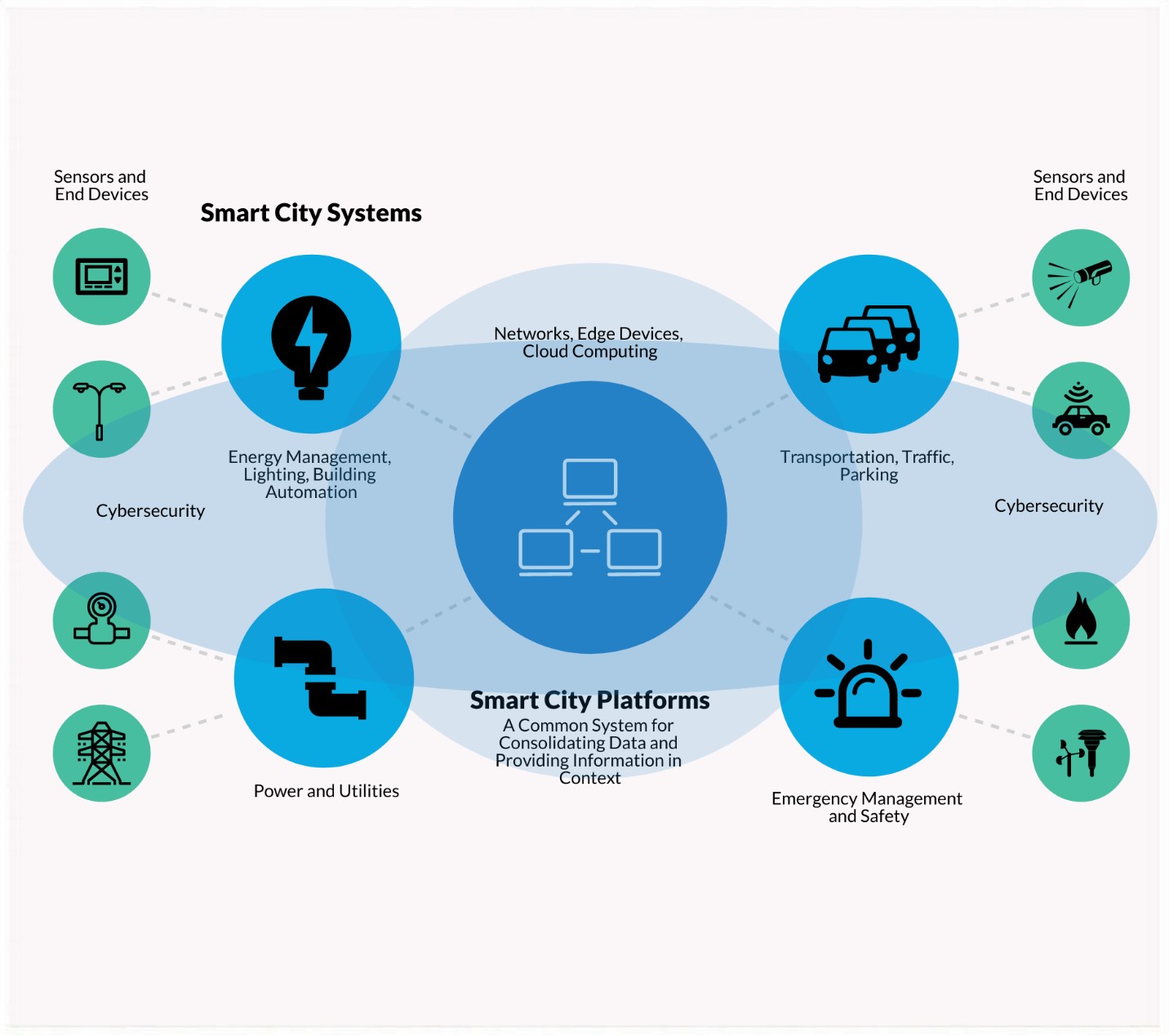What Is a Smart City Platform?
Cities are getting smarter. From the many small municipalities that have recently installed smart meters to measure electric power consumption, to the handful of large metropolises that have adopted a far-reaching and broad array of systems and technologies for all key functions, the world of smart cities is a huge challenge to navigate and understand.
Smart City Platforms
Smart cities are comprised of a “system of systems.” These can include smart city lightings, building automation systems, emergency management systems, security and access control systems, intelligent grids, renewable power, water treatment and supply, transportation, and more. The smart city concept is not new; many of these systems existed well before the term “smart cities” was coined. However, many end users are now attempting to integrate information from these disparate systems into a unified whole to provide a holistic view of the overall performance and state of the city and its various functions.

Smart City Platforms Provide a Common level of Abstraction and Manage Information from Multiple Smart City Systems
The age of the Internet of Things (IoT) has brought with it an increasingly broad range of sensors and IoT platforms. Many of these have made their way into the smart cities sector. In many ways, IoT technology holds the best promise for providing unification and context to the huge array of data generated by smart cities and turn this data into actionable, contextualized information that can be used to reduce energy consumption and operational costs while improving the safety and quality of life of citizens.
Smart City Platforms an IoT
In the Industrial Internet of Things architecture, smart city platforms reside at the enterprise level. These platforms perform many functions, including analytics, remote asset monitoring, performance management, decision support and/or presentation components. At a minimum, the functionality of a smart city platform must include:
• Visualization
• Application enablement
• Data management
The platform may also include:
• Cybersecurity
• Device management
• Network management
• Application development
• Analytics
• GIS
• Mobility
• Reporting
• Simulation
• Back office, and more…
Architecture of Smart City Platforms
Smart city integrated platforms may be deployed in a private, public, or hybrid cloud, via remote server, or on-premise. Private clouds are maintained by the platform provider. Amazon Web Services (AWS) is rapidly emerging as the most popular public cloud in this space. Hybrid public/private clouds are also a popular option, with the public cloud in place to serve peaks in data demand. More about Smart cities using Internet of Things Solutions.
Look for Information in Context
Cities can’t be “smart” unless the right people are empowered to make good decisions. Large networks of legacy systems, combined with new IoT-based sensors and systems, can make it challenging for smart cities to manage all these different data sources and turn the data into useful, actionable information. However, providing common actionable context for data from those myriad sensors and systems creates many opportunities to improve performance, increase safety, reduce lifecycle cost, and improve citizens’ quality of life.
Information in context means providing the right information to the right people at the right time in a well-understood and actionable manner. Information in context is an urgent requirement in today’s smart, connected cities. Data from 20- or 30-year old legacy systems exist alongside data from brand new systems for smart lighting, air quality management, and many other subsystems. So, how can we turn these data into useful information that people can act upon quickly and effectively?
More about Smart City and Industrial IoT Applications
The Need for Interoperability
In a data-driven society, the sheer volume of data is accelerating on an upward slope. Our reliance on human-machine collaboration to be successful will require the velocity, veracity, security and the universal interoperability of data. The explosion in hardware vendors, the number of communication protocols, and the lack of standardization of metadata and labeling among system integrators have created an environment in which data brokering between devices may be lost in translation or broken. The desired flow of data back and forth between databases, levels of the technology stack, applications, industries, regions, countries and freely throughout the global economy does not yet exist. The vision of machines flowing seamlessly around us and enhancing our lives sounds wonderful, but this utopia will remain a fantasy if communication barriers remain and the data the sensors are collecting cannot be used to provide contextual awareness.
Vendors have always preferred proprietary and closed systems since these tend to garner premium prices and lock a customer into a specific vendor. Cities should take advantage of the potential power they now have to collaborate to accelerate and institute radical changes to the smart city market. The EU has been working strategically with FIWARE and the Open and Agile Smart Cities (OASC) group to standardize on the same open-source platform. This standardization effort has spread to Brazil, Mexico, and most recently to Japan with its new partner, NEC. The EU is working on setting a single standard for data brokering between countries, as the ability to pool data into data oceans over data lakes will (in theory) generate deeper and more accurate analytical insights.
This is something that needs to be dealt with here in the US at the federal, state, and city levels and solved globally as economies and currency become ever-more digitized. Who owns and has access to the data? Technology outpaces policy, often making municipalities hesitant to invest early. For example, spending a few million dollars to deploy security cameras that the citizens or their representatives deem to be an invasion of privacy is clearly not worth the risk. US DOT does have many well-documented interoperability standards for various transportation subsystem like traffic signals and lighting systems.
Focus on Business Value, Not Just Technology
Smart cities and infrastructure are being driven by a whole new landscape of applications, platforms, networking, and other technologies. The sheer variety of potential solutions can make it extremely challenging for cities, municipalities, governments, and other users of smart city technology to make good strategic decisions.
ARC Advisory Group has always stressed that any technology should be evaluated from the standpoint of business value. The new generation of smart city platforms offers real economic benefits and the potential to greatly improve quality of life while preserving/enhancing the natural environment. Evaluating suppliers for their respective platform and data management capabilities will be increasingly important.
Providing business value means providing a focus on lifecycle and operational cost reductions, not just capital cost. LED lighting systems, for example, provide a good value proposition because of overall reduced energy consumption, and dramatically reduced maintenance schedule. However, the combination of IoT-enabled smart lighting systems and the data they provide with other applications can deliver even greater value. More about What is Universal automation?
ARC’s Report on Smart City Platforms
ARC’s report on smart city platforms focuses on enterprise-level platforms developed for cities that provide centralized operations and collaborative city-wide solutions through the enablement of applications for transportation, water, environmental, energy, security, governance, facility management, asset management, and more. The digitization of municipal, county, state, and other public agency services provides a platform for continuous improvement to a city’s liveability, citizens lives, business environment, and visitor experience. This research is focused on the platform and its components and includes services. It expressly does not include the revenues associated with device connectivity and edge sensors or software. Enterprise smart city platform providers who do not have their own device connectivity platforms typically partner with providers who do.
More about City Digitalization and City 4.0
This article was written by Larry O’Brien from ARC Advisory Group and originally it was published here.



